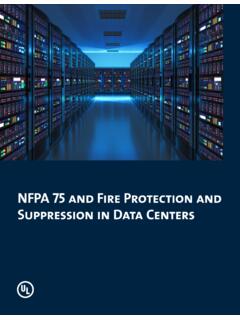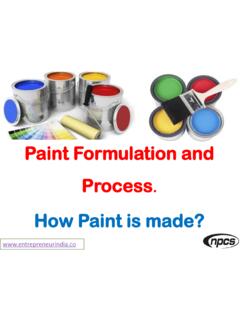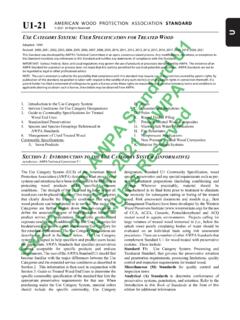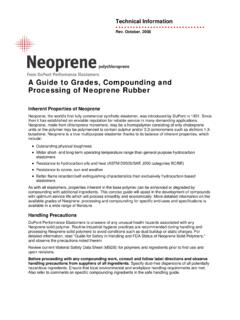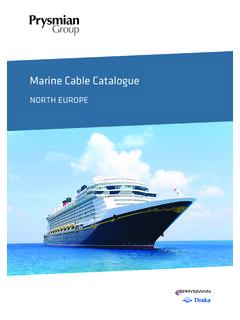Transcription of THERMAL BARRIERS AND IGNITION BARRIERS FOR THE …
1 THERMAL BARRIERS AND IGNITION BARRIERS FOR THE SPRAY POLYURETHANE FOAM INDUSTRY Copyright: December 2011 Page 2 THERMAL BARRIERS AND IGNITION BARRIERS FOR THE SPRAY POLYURETHANE FOAM INDUSTRY TECHNICAL OVERSIGHT COMMITTEE *SPFA would like to acknowledge the voluntary contributions of these individuals in the revision of this document. NOTE: This brochure was developed to aid specifiers in choosing spray-applied polyurethane foam systems. The information provided herein, based on current customs and practices of the trade, is offered in good faith and believed to be true, but is made WITHOUT WARRANTY, EITHER EXPRESS OR IMPLIED, AS TO FITNESS, MERCHANTABILITY, OR ANY OTHER MATTER. SPFA DISCLAIMS ALL LIABILITY FOR ANY LOSS OR DAMAGE ARISING OUT OF ITS USE. Individual manufacturers and contractors should be consulted for specific information.
2 Nominal values which may be provided herein are believed to be representative, but are not to be used as specifications nor assumed to be identical to finished products. SPFA does not endorse the proprietary products or processes of any individual manufacturer, or the services of any individual contractor. Participating Members Roger Morrison (Chair)* Deer Ridge Consulting John Hatfield Penta Roofing Consultants Eric Banks BASF Corporation Robert Smith Invista Jose Luna Bayer Materials Science David Mulkey Invista John Linnell Bayer Materials Science John Stahl* Preferred Solutions, Inc. Eric Machemer* Foam Run Xuaco Pascal Honeywell Bruce Schenke BASF Corporation Mary Bogdan Honeywell James Andersen BASF Corporation Joshua Ackerman Huntsman Chuck Skalski Gaco Western John Evans Icynene Mac Sheldon* Demilec Peter Birkbeck Icynene Chris Porter Bio-Based Insulation Mason Knowles* Mason Knowles Consulting Jay Zhang Convenience Products Jason Hoerter* NCFI Polyurethanes Tony Leonard ER Systems Jack Moore West Roofing Systems.
3 Inc Stuart Hayes Evonik-Goldschmidt Corporation Steve Crain The Dow Chemical Company Ray Geiling Evonik-Goldschmidt Coporation Don Lenaker Page 3 THERMAL BARRIERS AND IGNITION BARRIERS FOR THE SPRAY POLYURETHANE FOAM INDUSTRY POLICY STATEMENT It is the policy and recommendation of the Spray Polyurethane Foam Alliance that spray polyurethane foams installed within buildings be covered with a THERMAL or IGNITION barrier as soon as possible after the initial application, except as an assembly specifically approved by a building code authority based on fire tests specific to the application. Why Do Codes Require THERMAL or IGNITION BARRIERS ? Spray polyurethane foam (SPF), like most other organic materials, is combustible. SPFs are formulated with flame retardants to decrease the flame spread as measured by ASTM E-84 (Test for Surface Burning Characteristics for Building Materials) and other tests.
4 However, these flame spread indices are used solely to measure and describe properties of products in response to heat and flame under controlled laboratory conditions. The numerical flame spread indexes are not intended to reflect hazards presented by SPFs or any other material under actual fire conditions. When exposed to fire sources, such as trash fires, welding arcs, cutting torches, or red-hot metal, unprotected SPF can ignite and may result in a flash fire. Although burning SPF will form a surface layer of less flammable char, the initial burning can produce combustible gases and black smoke. In confined interiors, these combustible gases can accumulate and ignite resulting in flashover, a dangerous fire situation. Under these conditions, additional foam and/or other combustibles can become involved in the fire creating additional combustible gases and feeding the fire.
5 For these reasons, and to allow sufficient time for occupants to escape during a fire, model building codes require SPF to be covered by THERMAL BARRIERS , IGNITION BARRIERS or have the SPF assemblies meet the acceptance criteria of large-scale fire tests as described in this document. Note 1: These fire scenarios depend on the accumulation of combustible gases. Exterior applications of SPF, such as roof systems, where combustible gases can dissipate, are less likely to become involved in flash fires and are subject to different requirements under the model building codes. What Is A THERMAL Barrier? A THERMAL barrier is a material, applied between foam plastics (including spray polyurethane foam) and interior spaces designed to delay the temperature rise of the foam during a fire situation and to delay or prevent the foam's involvement in a fire.
6 The International Building Code (IBC) and the International Residential Code (IRC) define an approved THERMAL barrier as one which is equal in fire resistance to mm (1/2 inch) gypsum wallboard. In essence, the model building codes define -inch gypsum wallboard as a prescriptive THERMAL barrier; approved equivalents (non-prescriptive THERMAL BARRIERS ) must perform as well as or better than -inch gypsum wallboard in fire testing as described below. Non-prescriptive THERMAL BARRIERS (termed equivalent THERMAL BARRIERS ) must undergo a temperature transmission fire test wherein the temperature rise of the underlying polyurethane foam is limited to not more than 121 C (250 F) after 15 minutes of fire exposure complying with the standard time temperature curve of ASTM E 119 (Test Methods for Fire Tests of Building Construction Materials).
7 Additionally, equivalent THERMAL BARRIERS must undergo a fire integrity test to establish that they will sufficiently remain in place during a fire scenario by passing a large-scale, 15-minute fire test. Equivalent THERMAL BARRIERS meeting this criterion are termed a 15-minute THERMAL barrier or classified as having an index of 15. In effect, equivalent THERMAL BARRIERS ( , other than the prescriptive -inch thick gypsum wallboard) must undergo two fire tests: Page 4 THERMAL BARRIERS AND IGNITION BARRIERS FOR THE SPRAY POLYURETHANE FOAM INDUSTRY (1) A temperature transmission test (such as a modified ASTM E 119, the actual THERMAL barrier test apparatus being smaller than the typical large-scale wall or roof/ceiling test assemblies); and (2) A fire integrity test (a large-scale fire test such as NFPA 286 [with a specific acceptance criteria defined within the IBC or IRC], UL 1040, UL 1715 or FM 4880).
8 NFPA 275 (Standard Method of Fire Tests for the Evaluation of THERMAL BARRIERS Used over Foam Plastic Insulation) is an approved test standard per AC 377 for equivalent THERMAL BARRIERS that incorporates both a temperature transmission fire test and a fire integrity test. Future editions of model building codes will likely include NFPA 275 as an acceptable test method. Under specific conditions, the temperature transmission test can be waived if approved by building code authorities on the basis of large-scale fire testing representing actual end uses. Many materials which are not 15-minute THERMAL BARRIERS per ASTM E 119 or NFPA 275, or classified as equivalent THERMAL BARRIERS have earned various building code acceptances as an alternate to the use of THERMAL BARRIERS over spray polyurethane foam (SPF) based on large-scale fire testing.
9 The assembly, consisting of either the exposed foam plastic or the foam plastic with a fire- retardant coating is tested using one of the following procedures: NFPA 286 Standard Methods of Fire Tests for Evaluating Contribution of Wall and Ceiling Interior Finish to Room Fire growth (Note: NFPA 286 does not include pass/fail criteria within it; the criteria is specifically defined within the IBC and IRC.) UL 1715 Fire Test of Interior Finish Material UL 1040 Insulated Wall Construction FM 4880 Building Corner Fire Test What is an IGNITION Barrier? Model building codes allow an exception to the THERMAL barrier requirement in attics and crawlspaces where entry is made only for repairs or maintenance (IRC) or for the service of utilities (IBC) [see Note 3 below]. In these cases: The foam plastic insulation is protected against IGNITION using one of the following IGNITION barrier materials: 1 -inch-thick (38 mm) mineral fiber insulation; 1/4-inch-thick ( mm) wood structural panels; 3/8-inch ( mm) particleboard (1/4-inch thick under the IBC) 1/4-inch ( mm) hardboard; 3/8-inch ( mm) gypsum board; Corrosion-resistant steel having a base metal thickness of inch ( mm); or 1 1/2 inch-thick cellulose insulation (per 2012 IRC) [Paraphrased from 2009 IRC Sections and 2009 IBC Section contains equivalent language.]
10 ] The materials referenced above from the IRC and IBC are termed prescriptive IGNITION BARRIERS . IGNITION BARRIERS do not afford as high a degree of protection from fire as THERMAL BARRIERS but are considered AC 377 is the Acceptance Criteria for Spray-Applied Foam Plastic Insulation published by International Code Council Evaluation Service (ICC-ES) for the purpose of preparing evaluation reports. Copies are available at the ICC-ES website Since alternative assemblies must undergo the same room corner fire test(s) as equivalent THERMAL BARRIERS , many manufacturers have foregone the temperature transmission testing ( , ASTM E 119). Such materials are not classified as equivalent THERMAL BARRIERS but may be used as an alternative assembly provided it has been approved by the code authority having jurisdiction.
